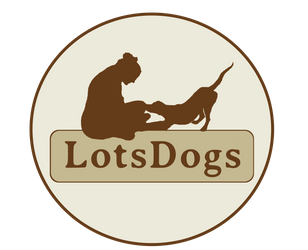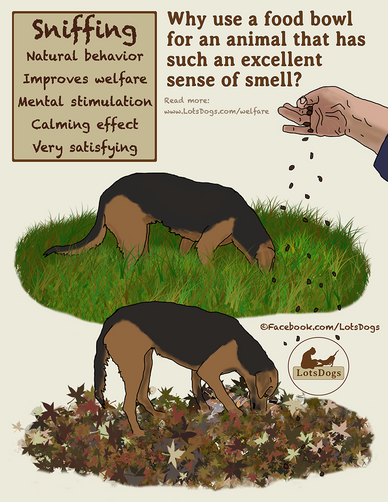Behavioural Needs of Dogs
All animal species show certain behaviours that are driven by a strong intrinsic motivation. The need to perform these behaviours arises from within the animal because it is naturally satisfying to do so. In regards to welfare certain behaviours can become behavioural needs when:
- The motivation to perform the behaviour is mainly intrinsic
- The need to perform the behaviour does not depend on the functional consequenses (i.e. with hunting dogs, even when offered free access to food, they will still feel the need to show hunting behaviour)
- The motivation to perform the behaviour only decreases after the behaviour(s) have been performed (they simply have to do it)
- Not being able to perform the behaviour has a negative effect on the animals welfare (i.e. hunting dogs who are never able to perform hunting behaviours, not even in a form of play, may become very frustrated or even depressed)
In example, research has shown that female pigs (sows) need to be able to perform nest building behaviour when they are pregnant. If this opportunity is taken away from them, they eventually become less fertile, which can be one of many side effects from compromised welfare.
Dogs are also born with behavioural needs. More research has to be done on this subject, but you can imagine that the breeding that humans have done with dogs may very well also have impacted these needs, creating breed-specific behavioural needs and breed- and type-specific differences.
In this article I will focus on behavioural needs which are very likely to benefit the welfare of all types and breeds of dogs.
Mental stimulation: an enriched environment
Research has shown that offering an enriched, mentally stimulating environment during the first six months of a dogs life, can decrease the risk of developing problem behaviours later in life.
Puppies need close guidance, but they also need to learn to self adapt, cope and to problem solve independently. Exploring, sniffing, chewing, all on their own pace, will help grow their confidence and decrease their chances of developing separation related problems.
Provide dogs with plenty of opportunities to explore the environment (sniffing is extremely important). Let them solve food puzzles (stuffed Kongs are also highly recommended) or just search for scattered food on the ground. This stimulates foraging behaviour, which is a natural behaviour to dogs who once evolved from being scavengers to in home companions.
It is important to also consider the emotional needs during these type of activities (think about avoiding frustration and keeping the dog in the ‘seeking’ mode) and the biological needs (safety, without the risk of getting injured). Sometimes guidance needs to be given to insure safety and pleasure and these needs may differ per dog.
Human family members with knowledge about dog behaviour
This is not a behavioural need for dogs, but because dogs live in such close proximity to humans, it is vital for their welfare that their human family members are aware of their needs. Dog family members will need to learn about welfare based dog training, using rewards and avoiding punishment. Dog training should always serve dog welfare. Building trust, strengthening the emotional bond, offering safety as well as physical and mental stimulation.
Physical stimulation - exercise
Though these needs will differ per individual (and age), every dog guardian should be aware of the exercise needs and temperament of their dog(s), before they decide to share their lives together. An important question to aks before bringing a dog to share your home and life with is: “Does your lifestyle and available time match with the welfare needs of this dog?”.
Do your welfare needs match with the welfare needs of your dog?
Most dogs (very average, it differs per dog type and age) will need one long walk and numerous short walks per day. Being able to run free and release built up energy will also benefit a dog's welfare greatly.
Social interactions
Dogs are highly social animals who (again, taking individual differences into account) are able to form social bonds fairly quickly and humans have selected them to behave extremely social towards humans.
Social interactions are a behavioural need for dogs. When dogs are left alone for 8 hours a day, 5 days a week, this can compromise their welfare and result in depression (reduced activity, reduced food intake, unresponsiveness) and illness (in the case of chronic stress).
© LotsDogs | Written by Liselot Boersma, welfare consultant (PgDip CABW) and owner of LotsDogs, may 2016; translated in 2020. Copy paste of images or text is forbidden. Sharing the URL of this website is very much appreciated. Many thanks in advance.
Research:
- Boissy, A., Manteuffel, G., Jensen, M.B., Moe, R.O., Spruijt, B., Keeling, L.J., Winckler, C., Forkman, B., Dimitrov, I., Langbein, J., Bakken, M., Veissier, I., Aubert, A. (2007). Review: Assessment of positive emotions in animals to improve their welfare. Physiolology & Behavior 92, pp. 375–397.
- Corridan, C. (2009) Basic requirements for good behavioural health and welfare in dogs. In Horwitz, D and Mills, D (ed.) BSAVA Manual of Canine and Feline Behavioural Medicine Second edition, pp. 24-34. Glousecter: British Small Animal Veterinary Association
- Landsberg, G. Hunthausen, W. and Ackerman. (2013). Prevention: the best medicine In Behaviour Problems of Dogs and Cats, pp. 39-55. Toronto: Saunders Elsevier.
- Manteca, X. (2016). Welfare of Companion Animals. Unpublished lecture notes of the first year of the Postgraduate Course in Companion Animal Behaviour and Welfare, Odisee University College, Department Gent.


